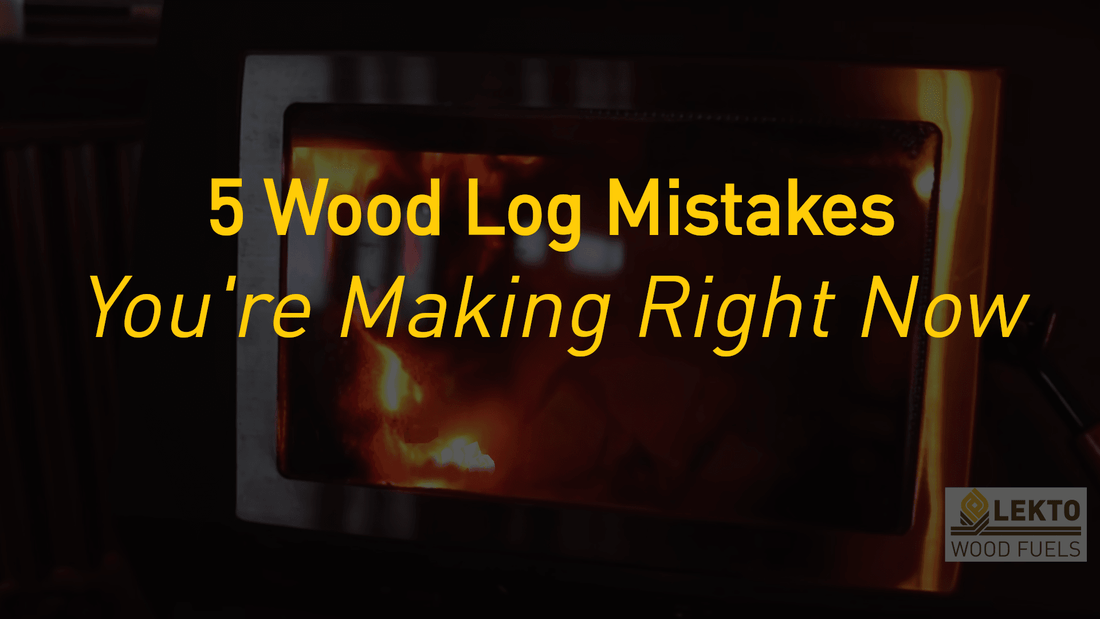
5 Firewood Log Mistakes (Millions of People Are Making Right Now)
Are you risking costly repairs, the possibility of burning down your house, and the health and well-being of your loved ones every time you fire up your wood stove?
As wood fuel experts with decades of collective experience, we’re seeing the same 6 big mistakes being repeated by heating wood users again and again. These mistakes not only lead to increased heating expenses and costly maintenance but they can also lead to serious health risks.
In this blog post, we’ll try to safeguard you from the possibility of expensive (and potentially life-threatening) problems arising during the heating season by telling you about these mistakes and teaching you how to avoid them.
By the time you finish reading this article, you’ll know more about wood stove use than 90% of people in Britain. And you’ll be able to enjoy a much more efficient, sustainable, cost-effective, and (most importantly) safe wood-burning experience.
So read on to discover the top mistakes you might be making and how to fix them in just a few steps.
Mistake #5: You’re Burning Wet or Poorly-Stored Wood
Burning wet wood is the prime reason why environmentalists dislike the idea of people using wood heat. When properly dried, Defra-certified wood logs and briquettes are burned, the heat extraction process is very efficient and emissions are minimal. But if you start to burn wet or improperly stored wood that contains a lot of moisture, then you’ll start having problems.
Expert tip: Purchase an inexpensive wood moisture meter and inspect your logs before use. Simple models cost as little as £20 on Amazon and will be more than good enough for household needs. What are acceptable moisture levels? It’s okay if the moisture levels vary from log to log but you need to make sure that the highest moisture level registered doesn’t exceed 20%.
Why You Shouldn’t Burn Wet or Unseasoned Wood:
- You get a lot less heat per log. Wet wood burns a lot less efficiently as a lot of energy is wasted on moisture evaporation.
- Wet wood burns at lower temperatures than dry wood.
- Wet logs produce a lot of harmful smoke when burned. The smoke contains thousands of kids of harmful particulate matter, which is damaging to human health and the environment.
- Burning wet wood leads to increased creosote buildup. This means you’ll have to hire a chimney sweep at least 3 times (which is costly) a year or risk serious damage to your appliance.
- As it contains a lot of moisture, wet wood is very hard to light, even if you’re using quality kindling and firelighters.
- Wet wood is a perfect home for mould and mildew, which will grow quickly and render your logs unsafe to burn.
Why Types of Wood Logs Are Unsafe to Burn?
- Unseasoned or wet logs. Burning wet or unseasoned logs is the worst thing you can do for yourself and your wood-burning appliance. Not only are you losing money due to low efficiency, but you’re also exposing your loved ones and your stove to damaging chemicals, such as creosote.
- Improperly stored logs. Even if you purchased quality Ready to Burn logs, you can still end up burning wet wood. Being ultra-dry, firewood logs soak up moisture like a sponge, if they’re not stored in a dry, well-ventilated area.
- Poorly seasoned logs. If you’re seasoning your own logs, it’s imperative that you’re stacking your firewood properly. Improper ventilation traps moisture, preventing your logs from drying and seasoning.
- Old, unrotated logs. Whenever possible, use the older logs before you use newer logs. Despite what many people believe, logs do have a limited shelf life. Ideally, you should use up your firewood within a year.
Mistake #4: Improper Wood Stove Maintenance
Another common mistake log burner users make is not maintaining their stoves properly. Wood burners are actually a lot more fragile than you might think. Failing to adequately maintain your stove will reduce the lifespan of your stove, decrease its efficiency, and create a safety hazard in your home due to dangerous creosote buildup.
Expert tip: Hire a certified chimney sweep who has up-to-date equipment for determining the structural integrity of your stove. You may pay a little bit in the short term, but you’ll save money in the long term.
Top 3 Most Common Wood Maintenance Mistakes
- Not hiring a chimney sweep regularly. Provided you use high-quality wood logs, you need to hire a chimney sweep at least once a year. Do this and your log burner will last you a very long time.
- Lack of proper ash removal. Allowing ash to build up in the fireplace or stove can impact air circulation and hinder the efficiency of your burner by decreasing oxygen’s ability to move around your logs.
- Failing to clean your stove's glass. This seemingly minor issue can have serious consequences. Not only is soot accumulation unsightly, but it can also reduce visibility and potentially cause damage to your stove.
- Overlooking rust and corrosion spots. Rust is the enemy of everything made of metal. And your wood burner is no exception. Neglecting to address rust and corrosion in a timely manner can lead to structural damage to your stove. If the problem isn’t remedied quickly, it can become a serious safety hazard.
Mistake #3: Using Your Stove Improperly
While burning wood logs in a wood stove may not feel like rocket science, there are many ways in which one might slip up during the process. Using your stove incorrectly can result in permanent damage and a fire hazard.
Expert tip: Read up on proper stove usage. You can understand the basics from reading our blog, but your stove’s use and care guide is the best place to find out what’s best for your appliance.
Top 5 Most Common Wood Stove Usage Mistakes
- Your stove is poorly installed. We get it. Getting a certified technician to install a wood stove is oftentimes a lot more expensive than buying the stove itself. But this really isn’t something you should ever do yourself. An improperly installed wood stove can lead to ventilation issues, heat loss, and potential safety hazards. Several houses burn down every year in the UK due to poorly installed wood-burning stoves.
- You’re overloading the stove. It seems intuitive. You want your stove to give off more heat or burn for a longer time before needing to be refilled, so you stuff as many logs inside it as possible. This is a horrible idea with serious risks attached. Instead of adding more logs, simply use a hotter-burning (Hardwood Heat Logs) or a longer-burning (Night Briquettes) fuel to achieve an even better effect safely.
- Inadequate airflow controls. Most people in the UK simply open up their airflow controls to the maximum when they light up their burner and close it when the fire dies down. But doing so is not very efficient. Reducing the air intake will help your firewood burn longer and more efficiently, albeit at a cost of heat output. And such products as Night Briquettes are specifically designed to be used with minimal heat intake.
- Not monitoring your stove’s temperature. Unless you have a good, seasoned eye for stove temperature, it’s best to buy a stove with an integrated temperature meter or to purchase a third-party clip-on option. Failing to monitor the stove's temperature can result in overheating or, conversely, the under-extraction of heat. The first is downright dangerous and the second costs you a lot of money in wasted logs.
Mistake #2: You’re Burning Wood That Shouldn’t Be Burnt
The Dunning-Kruger effect is a cognitive bias where individuals with a low level of ability or knowledge in a particular area tend to overestimate their competence. This phenomenon occurs due to the inability of less competent individuals to recognize the limitations of their knowledge.
So why are we telling you about the cognitive biases of unknowledgeable individuals in an article about wood fuels?
Because you should never burn anything but Ready to Burn logs or briquettes in your burner. Period. End of sentence.
That’s what our wood fuel experts say. Random people online will tell you otherwise. The first group has decades of collective experience in sourcing, creating, and using premium wood fuels. The second group will tell you that they’ve been burning toxic, chemically-treated wood in their burners for years and nothing bad has happened to them yet, so you should do so too.
Expert tip: Don’t burn anything that doesn’t have a Ready to Burn logo on it.
Top 3 Types of Wood You Should Never Burn
- Treated or painted wood. Refrain from burning chemically treated or painted wood as it will release toxic fumes into the air. And breathing in highly-toxic chemicals is never a good idea. (You’d be surprised how many people in our Facebook and YouTube comments can’t understand this).
- Using logs infested with mould and pests. Bringing wood with insects or mould inside can introduce said pests and mould into your home. Many people will give away such wood online, but even £0 is too much to pay for a chance to infest your home.
- Burning green or fresh-cut wood. “I’ll go to the forest and cut my own logs” is something we hear quite often. And the Dunning-Kruger effect is in full swing here. Fresh-cut wood has an enormously high moisture content and will produce more harmful smoke than heat.
Mistake #1: You’re Neglecting Fire Safety
During the 2021/2022 heating season, there were 334 fire-related fatalities in Great Britain. No fire, no matter how beautiful and warming, is worth burning down your home and losing your life over. So safety should always come first.
Expert tip: Never let your guard down near a burning fire. It’s a recipe for disaster.
Top 4 Fire Safety Mistakes
- Not providing enough clearance. Combustible materials should be put as far away from your stove as possible. Curtains, rugs, clothing, stuffed toys, furniture, and other easily combustible materials have no place near your stove.
- Not using a fire screen or spark guard. Always use a fire screen or guard when burning your stove. A stray spark can easily light a fire and result in a serious accident.
- Not having a fire extinguisher at the ready. It’s always best to prepare for the worst and hope for the best. Make sure your fire extinguisher (which you definitely should have) is in good repair and located in an easily reachable place. In many instances, the difference between a minor scare and a serious fire is measured in seconds.

